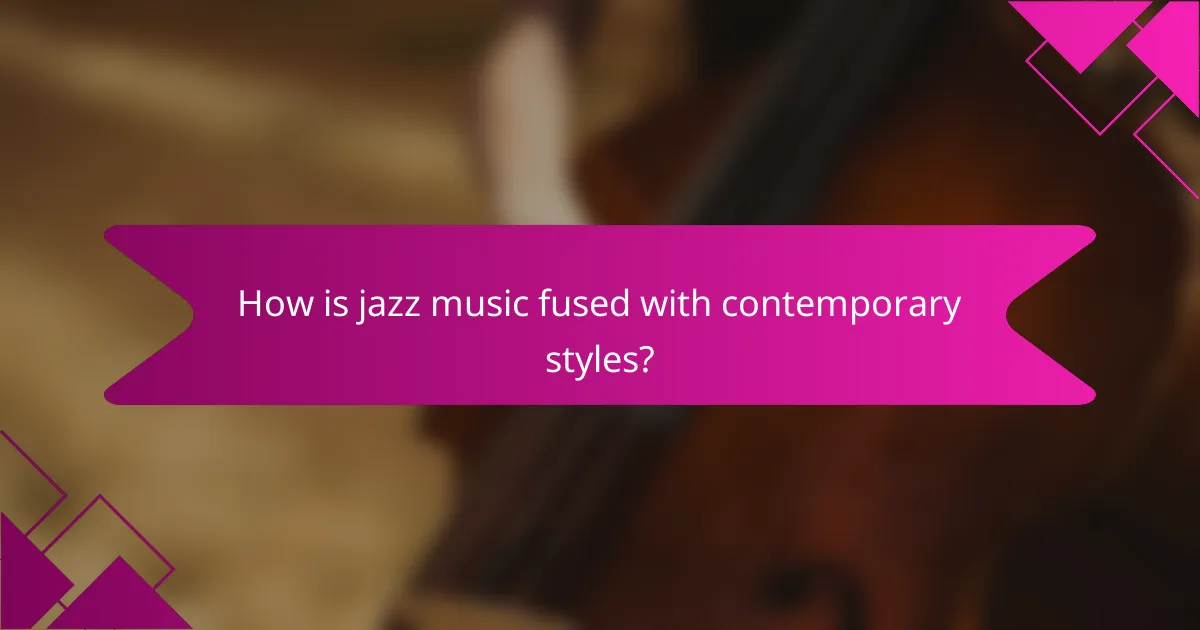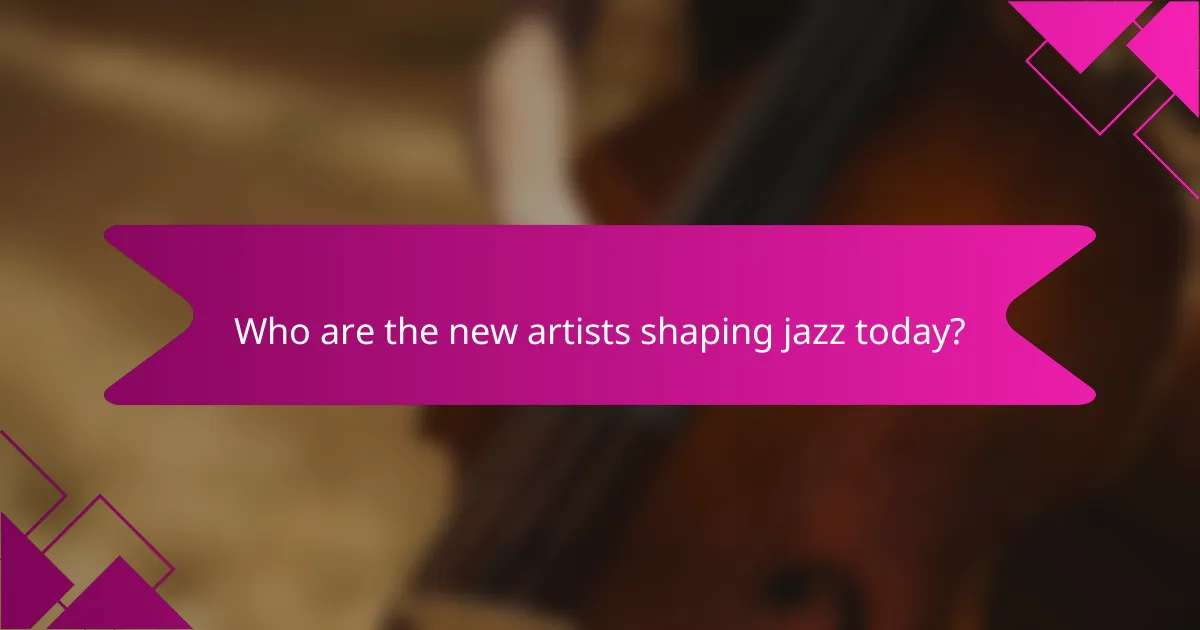Jazz music is evolving through its fusion with contemporary styles, resulting in innovative sounds that resonate with a global audience. By incorporating elements from genres such as rock, hip-hop, and electronic music, new artists are redefining the genre and expanding its reach, creating a vibrant and diverse musical landscape.

How is jazz music fused with contemporary styles?
Jazz music is increasingly blended with contemporary styles, creating innovative sounds that appeal to diverse audiences. This fusion often incorporates elements from genres like rock, hip-hop, electronic, and world music, resulting in fresh interpretations and new artistic expressions.
Jazz-Rock Fusion
Jazz-rock fusion combines the improvisational elements of jazz with the energy and instrumentation of rock music. This genre emerged in the late 1960s and is characterized by electric instruments, complex rhythms, and extended solos. Notable examples include bands like Weather Report and artists such as Miles Davis, who incorporated rock influences into his work.
When exploring jazz-rock fusion, consider the balance between improvisation and structured compositions. This genre often features intricate arrangements that allow musicians to showcase their technical skills while still maintaining a lively, engaging sound.
Jazz-Hop Collaborations
Jazz-hop merges jazz elements with hip-hop beats, creating a smooth, rhythmic sound that appeals to younger audiences. This fusion often features jazz samples, live instrumentation, and lyrical storytelling, exemplified by artists like A Tribe Called Quest and Robert Glasper. The combination of these genres allows for rich, layered compositions that highlight both musicality and lyrical depth.
To appreciate jazz-hop, listen for the interplay between the rhythm section and the melodic lines. The use of improvisation in jazz can enhance the spontaneity of hip-hop, making each performance unique.
Electronic Jazz Innovations
Electronic jazz innovations incorporate technology and electronic instruments into traditional jazz frameworks. This fusion can include synthesizers, drum machines, and digital effects, creating a modern sound that appeals to a tech-savvy audience. Artists like Flying Lotus and Kamasi Washington are known for pushing the boundaries of jazz through electronic elements.
When engaging with electronic jazz, pay attention to how technology enhances the improvisational aspects of jazz. The use of loops and samples can create a dynamic soundscape, allowing for new creative possibilities.
World Music Influences
World music influences in jazz introduce diverse cultural elements, rhythms, and instruments from various global traditions. This fusion enriches jazz by incorporating sounds from Africa, Latin America, Asia, and beyond. Musicians like Anoushka Shankar and Ibrahim Maalouf exemplify how these influences can create a unique blend of styles.
To explore world music influences in jazz, listen for the incorporation of traditional instruments and scales. This can lead to a richer, more textured sound that reflects the global nature of contemporary music.
Notable Artists in Fusion
Many contemporary artists are at the forefront of jazz fusion, each bringing their unique style and influences. Key figures include Esperanza Spalding, known for her blend of jazz, soul, and funk, and Snarky Puppy, a collective that combines jazz with various genres, including rock and world music.
When discovering new artists, consider attending live performances or exploring streaming platforms that feature fusion playlists. This can provide insight into how these musicians interpret and innovate within the jazz genre, showcasing the vibrant evolution of jazz music today.

What are the global trends in jazz music?
Jazz music is increasingly blending with contemporary styles, leading to innovative sounds that resonate globally. This fusion not only attracts new audiences but also encourages a diverse range of artists to emerge from various cultural backgrounds.
Emerging Jazz Scenes in Europe
Europe has seen a vibrant growth in jazz scenes, particularly in cities like Berlin, London, and Paris. These hubs foster creativity by combining traditional jazz with elements from electronic music, hip-hop, and world music.
Notable artists such as Kamasi Washington and Yussef Dayes are gaining recognition, showcasing how European influences can shape modern jazz. Local venues and collectives are crucial in promoting these emerging talents through regular performances and collaborations.
Jazz Festivals Around the World
Jazz festivals play a significant role in promoting the genre globally, with events like the Montreux Jazz Festival in Switzerland and the North Sea Jazz Festival in the Netherlands attracting thousands of attendees each year. These festivals not only feature established artists but also provide a platform for up-and-coming musicians.
Many festivals now include a mix of genres, reflecting the fusion trends in jazz. This approach helps broaden the audience and encourages cross-genre collaborations, making jazz more accessible to diverse listeners.
Impact of Streaming Platforms
Streaming platforms have revolutionized how jazz music is consumed, allowing artists to reach a global audience without traditional barriers. Services like Spotify and Apple Music enable listeners to discover new artists and genres effortlessly, contributing to the genre’s expansion.
However, the reliance on streaming can pose challenges for artists in terms of revenue. Many musicians are now exploring alternative income streams, such as live performances and merchandise, to supplement their earnings from digital platforms.

Who are the new artists shaping jazz today?
New artists are redefining jazz by blending traditional elements with contemporary styles, creating a dynamic and diverse sound. These musicians are not only innovating within the genre but also expanding its global reach, attracting audiences worldwide.
Kamasi Washington
Kamasi Washington is a prominent figure in modern jazz, known for his expansive compositions and rich soundscapes. His album “The Epic” has received critical acclaim, showcasing a fusion of jazz, soul, and classical influences.
Washington’s work often features large ensembles, incorporating strings and vocalists, which enhances the depth of his music. He emphasizes the importance of storytelling in jazz, making his performances both engaging and thought-provoking.
Esperanza Spalding
Esperanza Spalding is a versatile bassist and vocalist who has gained recognition for her innovative approach to jazz. Her ability to blend genres, including R&B and classical, has earned her multiple Grammy Awards, making her a significant influence in contemporary music.
Spalding’s albums, such as “Emily’s D+Evolution,” reflect her artistic evolution and willingness to experiment. She often incorporates elements of performance art into her shows, creating a unique experience that resonates with diverse audiences.
Christian Scott aTunde Adjuah
Christian Scott aTunde Adjuah is known for his unique sound, which he describes as “stretch music,” a blend of jazz with various global influences. His innovative use of instrumentation and rhythm pushes the boundaries of traditional jazz.
Scott’s work often addresses social issues, making his music both relevant and impactful. He encourages listeners to explore the connections between jazz and other musical traditions, fostering a greater appreciation for the genre’s versatility.
Shabaka Hutchings
Shabaka Hutchings is a key player in the contemporary jazz scene, known for his work with groups like Sons of Kemet and The Comet is Coming. His music often incorporates elements of Afro-Caribbean rhythms and electronic sounds, creating a vibrant and energetic style.
Hutchings emphasizes collaboration and community in his projects, often bringing together musicians from diverse backgrounds. This approach not only enriches his sound but also reflects the global nature of modern jazz.

What are the criteria for selecting contemporary jazz albums?
Contemporary jazz albums are typically evaluated based on production quality, innovative composition, and artist collaborations. These criteria help listeners identify albums that push the boundaries of jazz while maintaining its core elements.
Production Quality
Production quality is crucial in contemporary jazz, as it affects the overall listening experience. High-quality recordings ensure clarity and depth, allowing intricate musical details to shine. Look for albums that utilize modern recording techniques and professional mixing to enhance sound fidelity.
When assessing production quality, consider the use of both traditional and digital instruments. Albums that blend these approaches often achieve a richer sound, appealing to a broader audience. Pay attention to how well the album captures the nuances of live performances, as this can indicate a higher production standard.
Innovative Composition
Innovative composition is a hallmark of contemporary jazz, showcasing creativity and originality. Albums that incorporate diverse musical styles, such as electronic, world music, or hip-hop, often stand out. Look for unique arrangements that challenge conventional jazz structures while still respecting the genre’s roots.
Consider how the compositions evolve throughout the album. Tracks that feature unexpected shifts in tempo or key can keep listeners engaged and highlight the artist’s creativity. Additionally, albums that tell a story or convey a theme through their compositions tend to resonate more deeply with audiences.
Artist Collaborations
Artist collaborations play a significant role in contemporary jazz, often resulting in fresh sounds and perspectives. Collaborations between established and emerging artists can introduce innovative ideas and broaden the appeal of an album. Look for projects that feature a mix of genres, as these can lead to exciting musical fusions.
When evaluating collaborations, consider the chemistry between the artists. Successful partnerships often yield a seamless blend of styles, enhancing the overall quality of the music. Albums that showcase a variety of guest musicians can offer diverse influences, making them more dynamic and interesting for listeners.

How does jazz influence other music genres?
Jazz significantly influences various music genres by introducing complex rhythms, improvisation, and rich harmonies. Its adaptability allows it to blend seamlessly with styles like pop, hip-hop, and electronic music, creating innovative sounds that resonate globally.
Impact on Pop Music
Jazz has profoundly shaped pop music, especially through its incorporation of swing rhythms and melodic improvisation. Artists like Norah Jones and Michael Bublé have successfully fused jazz elements into their pop tracks, appealing to a broad audience. This blend often results in a more sophisticated sound that enhances the emotional depth of popular songs.
Jazz Elements in Hip-Hop
Hip-hop frequently samples jazz music, utilizing its intricate beats and improvisational style to create unique soundscapes. Notable artists such as A Tribe Called Quest and Kendrick Lamar have integrated jazz samples into their work, enriching their lyrical narratives. This fusion not only adds a layer of complexity but also pays homage to jazz’s historical roots in African American culture.
Cross-Genre Collaborations
Cross-genre collaborations between jazz musicians and artists from other genres have become increasingly common, leading to innovative music that transcends traditional boundaries. For instance, collaborations between jazz artists and electronic musicians often result in fresh, experimental sounds that attract diverse listeners. These partnerships encourage creativity and allow for the exploration of new musical territories, appealing to fans across multiple genres.
